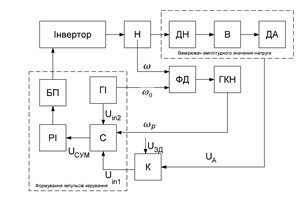Improving the Accuracy of the Output Voltage of the Converter by Changing the Load Parameters
Main Article Content
Abstract
In the article on the basis of the theory of invariance the increase of accuracy of work of system with the converter for nuclear magnetic logging under condition of change of parameters of loading is considered. Based on the proposed functional scheme of two-channel control, formulas are given to determine the structural relationships and internal influences on the parameters of the control system components to reduce the impact of disturbances that occur both by changing load parameters and by changing the supply voltage. To maintain the required value of the carrier voltage amplitude, it is necessary to increase the reference voltage or decrease the amplitude of the sawtooth voltage, which is equivalent to increasing the gain of the feedback circuit. In this case, if you increase the gain of the feedback circuit, you must ensure that the stability of the system is maintained. The implementation of these proposals gives a more accurate formation of the bypass probing signal. The given functional scheme provides realization of regulation and stabilization of amplitude. The paper considers various options for reducing the effect of power supply perturbation on the output parameters of the converter. By changing the period of operation of the sawtooth voltage generator, which is determined by the frequency of the voltage-controlled generator and depends on the output frequency of the inverter, which varies depending on the parameters and properties of the rock during logging, the accuracy of stabilizing the amplitude of the probe signal increases. In the proposed two-channel control system, the first channel provides regulation and stabilization of the amplitude of the output voltage in accordance with the reference voltage. The second channel provides a change in the frequency of the sawtooth voltage generator by determining the period of the voltage-controlled generator from the phase detector, which determines the deviation of the real frequency from the frequency of the reference generator. The application of the above techniques allows to build circuit implementations of the system with transducers for nuclear magnetic logging, which meet the requirements for the accuracy of the formation of the bypass probing signal.
Article Details

This work is licensed under a Creative Commons Attribution 4.0 International License.
Authors who publish with this journal agree to the following terms:- Authors retain copyright and grant the journal right of first publication with the work simultaneously licensed under a Creative Commons Attribution License that allows others to share the work with an acknowledgement of the work's authorship and initial publication in this journal.
- Authors are able to enter into separate, additional contractual arrangements for the non-exclusive distribution of the journal's published version of the work (e.g., post it to an institutional repository or publish it in a book), with an acknowledgement of its initial publication in this journal.
- Authors are permitted and encouraged to post their work online (e.g., in institutional repositories or on their website) prior to and during the submission process, as it can lead to productive exchanges, as well as earlier and greater citation of published work (See The Effect of Open Access).
References
G. Coates, L. Xiao та M. Prammer, NMR Logging Principles and Applications, Houston: Haliburton Energy Services, 1999.
R. Freeman, «Advances in NMR Logging,» Schlumberger Oilfield Services, т. 58, № 1, 2006. DOI: 10.2118/89177-JPT
A. V. Zagranychnyi and V. V. Rogal, "Methods of forming voltage probing for devices nuclear magnetic resonance," Electronics and Communications, vol. 18, no. 5 (76), pp. 19-24, 2013. DOI: 10.20535/2312-1807.2013.18.5.142741
A. Tyshko, S. Balevicius та S. Padmanaban, «An Increase of a Down-Hole Nuclear Magnetic Resonance Tool’s Reliability and Accuracy by the Cancellation of a Multi-Module DC/AC Converter’s Output’s Higher Harmonics,» IEEE Access, т. 4, pp. 7912 - 7920, 2016. DOI: 10.1109/ACCESS.2016.2624498
A. V. Zahranychnyi and V. V. Rogal, "Application of inverters in the nuclear magnetic resonance devices," Tehnichna elektrodynamika, no. 5, pp. 139-141, 2014. URL: http://previous.techned.org.ua/2014_5/st46.pdf
V. N. Nesterov and A. R. Li, "Teoriya I praktika postroyeniya invariantnykh izmeritelnykh preobrazovateley i system," Izvestiya Samarskogo nauchnogo tsentra Rossiyskoy akademii nauk, vol. 18, no. 4 (7), pp. 1414-1422, 2016.
Sandipan Patra, Sanjay Agrawal, Soumya R Mohanty, Vineeta Agarwal and Malabika Basu, "ESPRIT based robust anti-islanding algorithm for grid-tied inverter," 2016 IEEE Students’ Technology Symposium (TechSym), 2017. DOI: 10.1109/TechSym.2016.7872661
J. Rodriguez Perez та Patricio Cortes Estay, Predictive control of Power Converters and Electrical Drives, Hoboken, NJ: Wiley-IEEE Press, 2012. ISBN: 978-1-119-96398-1
P. Rodriguez, «Multilevel-clamped multilevel converters (MLC 2),» IEEE Trans. Power Electron, т. 7, № 3, pp. 1055-1060, 2012. DOI: 10.1109/TPEL.2011.2172224
M. S. A. Dahidah, G. Konstantinou та V. Agelidis, «A review of multilevel harmonic elimination PWM: Formulations solving algorithms implementation and applications,» IEEE Trans. Power Electron, т. 30, № 8, pp. 4091-4106, 2014. DOI: 10.1109/TPEL.2014.2355226
V. Y. Zhuykov, V. V. Rogal та O. V. Budyonnyi, Energetychna elektronika, Kyiv: electronic textbook, 2009. URL: http://eds.kpi.ua/wp-content/uploads/2021/04/EE/index.htm
A. V. Zachranychnyi and A. Y. Manzhelii, "Pokrashchennia spektralnoho skladu," Microsystems, Electronics and Acoustics, vol. 26, no. 2, 2021. DOI: 10.20535/2523-4455.mea.237413
K. Fathy, Y. Miura, K. Yasui, I. Hirota and T. Iwai, "PWM/PDM dual mode controlled soft switching multi resonant high-frequency inverter," 2005 IEEE International Conference on Industrial Technology, 2005. DOI: 10.1109/ICIT.2005.1600863
Xiaoyu Wang and Walmir Freitas, "Influence of Voltage Positive Feedback Anti-Islanding Scheme on Inverter-Based Distributed Generator Stability," IEEE Transactions on Power Delivery, vol. 24, no. 2, pp. 972 - 973, 2009. DOI: 10.1109/TPWRD.2009.2013373
Hong Li, Chen Liu, Ying Zou та Xiaheng Jiang, «A Stability Improvement Method Based on Parameter Sensitivity for Grid-connected Inverter,» IECON 2020 The 46th Annual Conference of the IEEE Industrial Electronics Society, 2020. DOI: 10.1109/IECON43393.2020.9254964
Bo Zhang and Xuemei Wang, "Invariant Probability Distribution of DC–DC Converters," Wiley-IEEE Press, pp. 75-91, 2013. DOI: 10.1002/9781118451106.ch4
Xiao Liu, Aaron M. Cramer and Fei Pan, "Generalized Average Method for Time-Invariant Modeling of Inverters," IEEE Transactions on Circuits and Systems I: Regular Papers, vol. 64, no. 3, pp. 740 - 751, 2016. DOI: 10.1109/TCSI.2016.2620442





